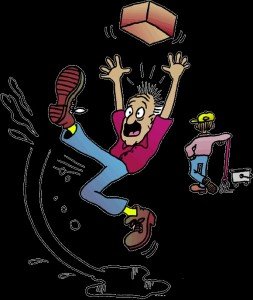 The main causes of slips, trips, and falls in the workplace are:
The main causes of slips, trips, and falls in the workplace are:
- Poor housekeeping: Scrap on floors; spilled liquids; electrical, network or phone cords; equipment cluttering the aisles; all of these scenarios can lead to someone slipping and falling if we simply ignore these hazards. You may think someone else will take care of it, but that may not happen in time to prevent an accident.
- Dangerous surface conditions: Broken or cracked surfaces, protruding nails, different elevations which are unmarked, torn carpets, loose or curled mats and slippery finishes are all hazards.
- Insufficient lighting: Dim or incorrect lighting, glare in areas where it is dangerous or lights which flicker or “strobe” and cause perception difficulties.
- Inattention to tasks: Carelessness brought on by inexperience, horseplay, fatigue, or personal problems.
- Improper footwear: Shoes which are not properly fastened, are too big, too small, have slippery bottoms or oversized heels.
Here are some ways to prevent this common but sometimes deadly kind of accident:
- Conduct regular safety inspections of your work area to identify and remove slipping and tripping hazards.
- Keep your work area and traffic areas free of tripping hazards such as stored materials, scrap, cables, cords and unnecessary equipment or tools. Tool boxes are common tripping hazards, so keep them out of the way.
- Close drawers and cabinet doors to prevent someone from falling over them.
- Promptly clean up all spills. Rainwater in a doorway, coffee on a hall floor, or oil leaking from machinery are all common slipping hazards. Help keep the floors dry in lunchrooms and washrooms, too.
- Watch where you are going. Don’t try to walk while focusing on your smart phone, reading something, or carrying an object you can’t see over.
- Don’t walk backwards. Many tripping accidents occur when a person backs up and trips over something.
- Take your time; don’t run or rush. It is especially important to slow down on wet floors, icy pavement, and sloped surfaces.
- Make sure the lighting is good in your work and traffic areas. Many accidents involving falls occur in dark storerooms and dim hallways.
- Have your vision checked regularly and change your prescription eye-wear as required.
- Wear footwear that helps you to stay on your feet. Shoes should be well-fitting with low heels. Soles should be made of a non-slip material for most work situations. Footwear with treads or cleats may be called for in some jobs.
Check your work area and your work habits frequently to make sure you are doing all you can to prevent slips, trips, and falls. Practice good work-site housekeeping, wear well-fitting shoes, and pay attention to where you are stepping.
